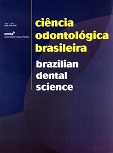Avaliação in vitro da transposição de obstruções da embocadura de canais radiculares com e sem auxílio do microscópio clínico operatório
DOI:
https://doi.org/10.14295/bds.2008.v11i4.669Abstract
A presença de obstruções físicas na embocadura do sistema de canais radiculares, seja por fatores biológicos, como calcificações, seja por fatores restauradores ou iatrogênicos, representa uma situação indesejada que muitas vezes compromete o sucesso do tratamento endodôntico. A maior dificuldade para a remoção ou transposição das obstruções é a visualização de um campo tão pequeno e escuro. O propósito desta pesquisa foi avaliar o uso do Microscópio Clínico Operatório (MCO), como auxiliar, na transposição de obstruções da embocadura de canais radiculares, situação clínica comum no cotidiano do endodontista, através da utilização de brocas em baixa rotação. Foram utilizados 30 molares humanos extraídos, onde, após o acesso à câmara pulpar um operador realizou as obstruções e outro as desobstruções ou transposições. As simulações de obstruções foram confeccionadas com resina Z-250. As desobstruções foram realizadas com brocas esféricas de haste longa em baixa rotação nº 1/2, 1 e 2. Em 15 dentes a remoção das obstruções foi feita a olho nu (grupo G1), e nos outros 15 foi feita com auxílio do MCO (grupo G2). Radiograficamente observou-se que no G1 houve maior desgaste de dentina. O tempo médio para a transposição das obstruções foi de 24,6 minutos no G1 e 18,2 minutos no G2 (p>0,05). Seis raízes foram perfuradas no G1 e apenas uma no G2 (p<0,05). Levando em consideração as condições do experimento, podemos concluir que a utilização do MCO como auxiliar na transposição de obstruções dos canais radiculares pode propiciar menor risco de perfuração radicular e menor desgaste de dentina.
Downloads
Downloads
Published
How to Cite
Issue
Section
License
Brazilian Dental Science uses the Creative Commons (CC-BY 4.0) license, thus preserving the integrity of articles in an open access environment. The journal allows the author to retain publishing rights without restrictions.
=================




























